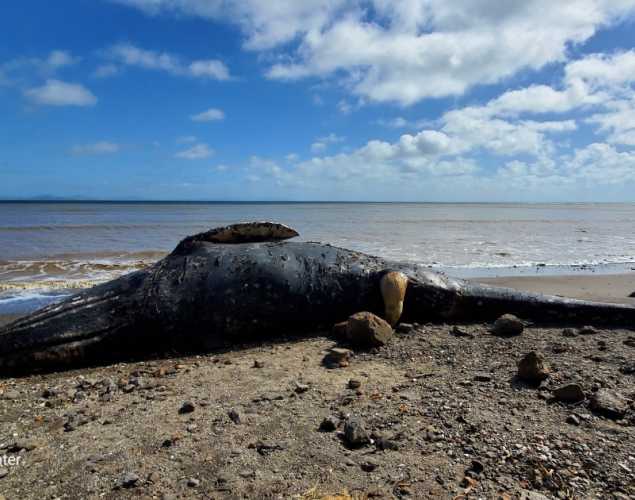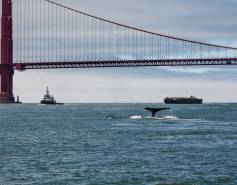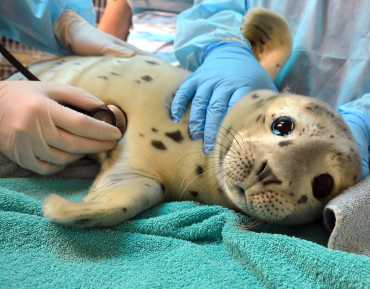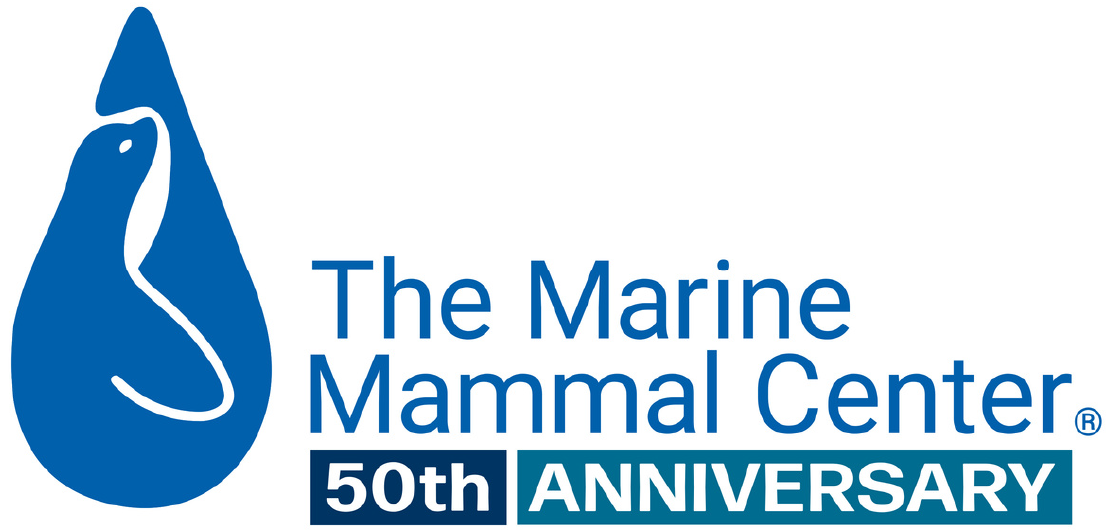
Blunt Force Trauma Due to Vessel Strike Suspected Cause of Death for Gray Whale at Bolinas Beach
- Pathology
The necropsy response is the first in the San Francisco Bay Area in 2023 during the species’ ongoing Unusual Mortality Event
Scientists at The Marine Mammal Center, the world’s largest marine mammal hospital, and their partners at the California Academy of Sciences suspect a gray whale that washed ashore at Bolinas Beach last week died from blunt force trauma due to vessel strike. By investigating deaths like this, the Center can identify and respond to rapidly changing environmental trends as well as human impacts on marine mammal populations.
Gray whales are ocean sentinels due to their adaptability and foraging habits. They have a lot to tell us about the health of the ocean, so to see the species continue to face the added threats of human interaction should concern all of us.
“Gray whales are ocean sentinels due to their adaptability and foraging habits. They have a lot to tell us about the health of the ocean, so to see the species continue to face the added threats of human interaction should concern all of us,” says Dr. Pádraig Duignan, Director of Pathology at The Marine Mammal Center. “This case reinforces the need for us to continue to perform both observational research of live whales as well as necropsy investigations so that this critical data can be shared with key decision-makers to find actionable solutions.”
In a necropsy, or animal autopsy, conducted Saturday, March 25, a team of 15 scientists identified the whale as a 35-foot subadult male in normal body condition based on the fat stores and blubber layer and that there was a moderate amount of decomposition consistent with up to two days since time of death.
Bruising and hemorrhage in the soft tissue on the left side of the whale’s head around the left eye and extended back to the C1 vertebrae at the base of the skull. This is indicative of blunt force trauma that occurred while the whale was alive, and the scale of the trauma is consistent with vessel collision as the cause of death.
Due to the position of the whale, the team was only able to examine the left side of the spine and ribs as well as the abdomen in detail but there were no remarkable findings in these organs. The team did not discover any broken bones and noted minimal stomach contents.
The greatest threats to marine mammals are caused by people, but we can also be their greatest champions.
Sign up for email from The Marine Mammal Center to stay updated on how you can support solutions and be an advocate and champion for marine mammals.
{"image":"\/Animals\/Wild\/Humpback whale\/cropped-images\/whale-tail-with-bridge-and-ships-shutterstock-3-7-4898-3826-1663722256.jpg","alt":"whale tails visible above water under the Golden Gate Bridge with shipping traffic in the distance","title":"Whale Safe \u2013 an AI-enabled System to Prevent Ship Collisions with Whales \u2013 to Launch off the San Francisco Coastline","link_url":"https:\/\/www.marinemammalcenter.org\/news\/whale-safe-to-launch-off-the-san-francisco-coastline","label":"Press Release","date":"2022-09-21 04:00:00","type":"news"}

Whale Safe – an AI-enabled System to Prevent Ship Collisions with Whales – to Launch off the San Francisco Coastline
September 21, 2022
Read More{"image":"\/Animals\/Wild\/Other species\/cropped-images\/leaping-dolphin-container-ship-shutterstock-4-0-2560-2000-1672429328.jpg","alt":"dolphin leaping in front of a giant container ship","title":"ZEIT Online: How to Save a Whale","link_url":"https:\/\/www.marinemammalcenter.org\/news\/zeit-online-how-to-save-a-whale","label":"In the News","date":"2022-12-30 01:00:00","type":"news"}

{"image":"\/Animals\/Wild\/Humpback whale\/cropped-images\/two-whales-under-golden-gate-bridge-shutterstock-646-1-3946-3083-1663782644.jpg","alt":"two whales surfacing below the Golden Gate Bridge","title":"New York Times: New System Aims to Save Whales Near San Francisco From Ship Collisions","link_url":"https:\/\/www.marinemammalcenter.org\/news\/new-york-times-new-system-aims-to-save-whales-near-san-francisco-from-ship-collisions","label":"In the News","date":"2022-09-21 02:00:00","type":"news"}

New York Times: New System Aims to Save Whales Near San Francisco From Ship Collisions
September 21, 2022
Read More{"image":"\/Animals\/Wild\/Gray whale\/cropped-images\/gray-whale-san-francisco-bay-with-ship-by-bill-keener-c-the-marine-mammal-center-22-3-1925-1504-1670545385.jpg","alt":"whale tail above the water with a ship in the distance","title":"NBC: Cruises & Cargo Ships Regularly Break Voluntary Speed Limit Aimed at Protecting Endangered Whales","link_url":"https:\/\/www.marinemammalcenter.org\/news\/nbc-cruises-cargo-ships-regularly-break-voluntary-speed-limit-aimed-at-protecting-endangered-whales","label":"In the News","date":"2022-12-05 09:26:58","type":"news"}

NBC: Cruises & Cargo Ships Regularly Break Voluntary Speed Limit Aimed at Protecting Endangered Whales
December 5, 2022
Read More"When a whale strands along the coast it allows us the unique opportunity to study the animal up close. It was a relief to see this young male gray whale in such good body condition with a thick layer of blubber and lots of fat and oil,” says Moe Flannery, Senior Collections Manager of Ornithology and Mammalogy at the California Academy of Sciences. “Although it is the first stranding of the year in the Bay Area, we are hopeful the good body condition is an indicator that the species is doing better now compared to the last few years."
Elevated numbers of dead gray whales washing ashore in poor body condition since early 2019 across the species’ entire migratory range caused the National Oceanic and Atmospheric Administration (NOAA) to declare an Unusual Mortality Event (UME) that is ongoing.
According to NOAA, the number of gray whales migrating along the West Coast has dropped 38 percent during the UME to an estimated 16,650 whales since the last population assessment in 2015/2016, when whale numbers peaked at an estimated 26,960 whales.
Malnutrition, entanglement and trauma from vessel strikes are the most common causes of death in whales identified by the Center’s research team in recent years. The Center’s team participates as an investigator on NOAA’s gray whale UME working group, which assesses those factors as well as the impacts from harmful algal blooms, infectious disease, natural predation, and other human interactions.
Researchers from the Center have observed at least four live gray whales in the San Francisco Bay since this year’s first sighting on February 8. The whales are staying for longer durations as a layover on their migration than they did prior to the UME, and Center experts also documented them feeding in the Bay. Gray whales are currently in the process of migrating north along the Pacific west coast from their mating and birthing grounds near Baja, Mexico, to their traditional feeding grounds in Arctic waters.
It is critical for boaters and people on the water to keep a safe distance from whales and report sightings to the Center’s website. All marine mammals are federally protected, and the public should not approach any whale, alive or dead.
The Center’s researchers study the locations and behaviors of whales in San Francisco Bay so that informed decisions can be made to better protect whales. Public funding and support for this investigatory work is essential.
Scientists from The Marine Mammal Center and the California Academy of Sciences were able to collect a series of samples for ongoing research projects. Typically, the California Academy of Sciences archives various parts of each specimen (baleen, pelvic bones, blubber, muscle, etc.) in their scientific research collection thus making them available to scientists from around the world.
The team was first notified of the dead whale at Bolinas Beach east of Duxbury Point on March 23 and a small team of experts from the Center and the California Academy of Sciences responded the same day to take initial samples prior to the necropsy investigation. Due to the tide cycle and weather, the team of scientists had a limited window to conduct the investigation safely at low tide.
2022 Whale Responses
7 gray whales, 3 humpback whales
Necropsy findings: 1 malnutrition, 1 suspect orca predation, 4 ship strikes, 4 undetermined
March 5, 2022: adult female gray whale, Limantour Beach, Point Reyes National Seashore; cause of death: malnutrition
April 4, 2022: subadult female gray whale, Muir Beach, Golden Gate National Recreation Area; cause of death: ship strike
April 5, 2022: adult male gray whale, Alameda; cause of death: unknown, only limited samples taken and no necropsy performed
April 29, 2022: adult male gray whale, Rockaway Beach, Pacifica; cause of death: ship strike
May 13, 2022: adult female gray whale, Fort Funston, San Francisco; cause of death: ship strike
May 20, 2022: adult male gray whale, Don Edwards National Wildlife Refuge, Mountain View; cause of death: unknown, only limited samples taken and no necropsy performed
June 19, 2022: adult male gray whale, Slide Ranch, Marin County, cause of death: unknown, only limited samples taken and no necropsy performed
July 14, 2022: humpback whale, North Beach, Point Reyes National Seashore, cause of death: undetermined
July 17, 2022: subadult female humpback whale, Sharp Park, Pacifica, cause of death: suspect orca predation
August 28, 2022: adult female humpback whale, Manhattan Beach, Half Moon Bay, cause of death: ship strike
For more information or to set up an interview on this topic, please contact us at media@tmmc.org.
For breaking news about our whale responses as well as additional press materials, bookmark MarineMammalCenter.org/whale-stranding.
Yes, I want to save a life!

Yes, I want to save a life!
You’ll be giving sick and injured animals the best possible care at the Center’s state-of-the-art hospital. With your gift today, you are giving a patient a second chance at life in the wild.
See Our Latest News
{"image":"\/Animals\/Patients\/Harbor seals\/2020\/cropped-images\/hs-barnwood-by-bill-hunnewell-c-the-marine-mammal-center-315-0-3299-2577-1607370547.jpg","alt":"harbor seal Barnwood","title":"Last-Minute Gift Guide \u2013 Top Gifts that Give Back to Marine Animals","link_url":"https:\/\/www.marinemammalcenter.org\/news\/last-minute-gift-guide","label":"News Update","date":"2025-12-18 01:00:00"}

Last-Minute Gift Guide – Top Gifts that Give Back to Marine Animals
December 18, 2025
Read More{"image":"\/Animals\/Patients\/Hawaiian monk seals\/2025\/cropped-images\/b-ru72admission-to-ke-kai-ola112125photo-c-the-marine-mammal-center-noaa-permit-24359-0-364-1270-992-1766095407.jpg","alt":"A newborn Hawaiian monk seal pup with a black coat in rehabilitative care.","title":"Newborn Hawaiian Monk Seal Pup Now Receiving Care","link_url":"https:\/\/www.marinemammalcenter.org\/news\/newborn-hawaiian-monk-seal-pup-now-receiving-care","label":"Patient Update","date":"2025-12-18 01:00:00"}

{"image":"\/Animals\/Patients\/Hawaiian monk seals\/2025\/cropped-images\/d-ru28release-exam-at-ke-kai-ola111025photo-by-giancarlo-rulli-c-the-marine-mammal-center-noaa-permit-24359-0-0-1270-992-1764620886.jpg","alt":"","title":"Bird Flu Vaccine Trial Offers Hope for Protecting Hawaiian Monk Seals","link_url":"https:\/\/www.marinemammalcenter.org\/news\/bird-flu-vaccine-trial-may-offer-hope-for-protecting-hawaiian-monk-seals","label":"News Update","date":"2025-12-01 08:13:00"}

Bird Flu Vaccine Trial Offers Hope for Protecting Hawaiian Monk Seals
December 1, 2025
Read More{"image":"\/Animals\/Patients\/Hawaiian monk seals\/2021\/hms-pp08-by-sheila-latta-c-the-marine-mammal-center-noaa-permit-18786.jpg","alt":"Hawaiian monk seal","title":"The New York Times: Inside the Bird-Flu Vaccine Trial for Monk Seals","link_url":"https:\/\/www.marinemammalcenter.org\/news\/the-new-york-times-inside-the-bird-flu-vaccine-trial-for-monk-seals","label":"In the News","date":"2025-12-01 01:00:00"}

The New York Times: Inside the Bird-Flu Vaccine Trial for Monk Seals
December 1, 2025
Read More


